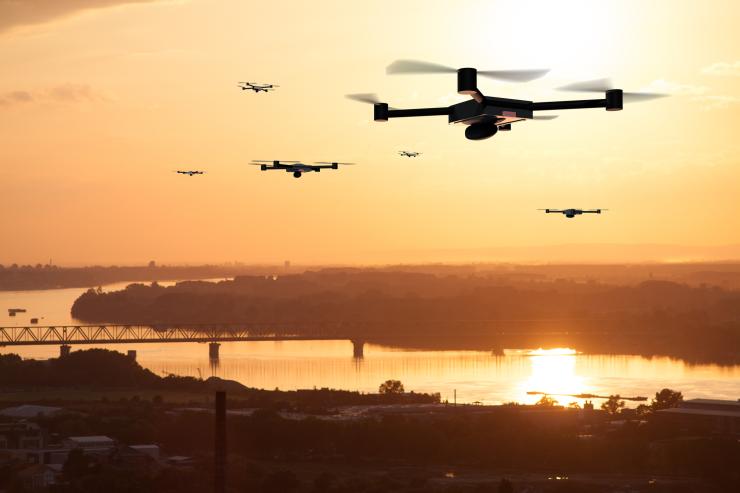PNT Chain Technique Could Help UAVs Navigate in a GPS-Denied World
Aug 22, 2022 — Atlanta, GA

GTRI researchers used this UAV to flight test PNT Chain techniques developed to provide navigation support in the absence of GPS services. (Credit: GTRI)
GPS signals are critical to military navigation, particularly for small and inexpensive autonomous UAVs where size, weight, and power (SWaP) limitations are critical. But because they rely on low-power radio frequency signals from orbiting satellites, these GPS navigation systems are susceptible to disruption by adversaries.
Concern about the potential loss of GPS data has led to development of alternative navigation approaches relying on sensor fusion techniques that combine information from sources such as vision systems, radio ranging, lidar, altimeters, measurements of the Earth’s magnetic field, and even sightings from celestial objects. These techniques, however, can’t provide a simple, direct, and low-cost replacement for GPS, especially on SWaP-limited UAVs.
Researchers at the Georgia Tech Research Institute (GTRI) are developing a collaborative and distributed navigation system that would allow swarms of autonomous UAVs to share position, navigation, and timing (PNT) data in real-time. By blending alternate PNT data and information from different air vehicles – some of which may have GPS access – the collaborative system could help a UAV swarm navigate to its destination despite a failure of the Global Navigation Satellite System (GNSS).
Known as the PNT Chain, this novel technique would enhance established alternative navigation sources should an adversary deprive UAVs of their primary navigation cues. The proof-of-concept technique has been evaluated in simulations and a limited flight test.
“We’ve developed the core distributed algorithms needed for a collaborative system that could dramatically improve GPS-denied navigation,” said Matthew Lashley, a GTRI senior research engineer who leads the project. “We’ve shown that the algorithms work with real sensor data and we have substantiated the feasibility of using the PNT Chain to help UAVs operate even if the GNSS fails. This could significantly improve the robustness and reliability of UAV teams.”
UAVs that are part of the PNT Chain would share whatever useful information they have with other members of the chain, and the resulting sensor fusion could allow PNT information to be projected over long distances.
Simulated flights across the continental United States and over the open water of the Pacific Ocean suggested that the PNT Chain could reduce navigation errors in GPS-denied areas by more than 100-fold. The simulated Pacific mission used 16 UAVs each equipped with an inertial measurement unit (IMU), compass, altimeter, monocular camera – and access to GPS for a portion of the mission. Visual sighting of two small islands contributed to the simulated navigation.
“The concept of the operation was to have a swarm of UAVs that may extend from a GPS-available region to a GPS-denied region, with ranging radios and the ability to share information,” explained Sam Shapero, a GTRI senior research engineer who is also working on the project. “By looking at the time-of-flight for signals to travel between UAVs, we can determine the distances between them.”
In the PNT Chain, nearby air vehicles communicate, but there is no central computing capability. The distributed system can tolerate the loss of vehicles and changes in the original chain structure.
For swarm UAVs, development of alternative PNT systems requires tradeoffs between capability, cost, and weight. “UAVs are always constrained by what they can carry,” Lashley noted. “An advantage for most UAVs is that they are relatively inexpensive, so you can’t have a million-dollar PNT system installed on them.”
Beyond UAVs, the PNT Chain technique could potentially be used to support GPS-denied navigation needs of ground vehicles, individual warfighters, larger air vehicles, ships and small boats – and even satellites.
As part of a three-year project supported by GTRI’s Independent Research and Development program, researchers tested their approach by modifying the SCRIMMAGE UAV simulation environment to evaluate the results from a variety of sensor inputs. They also developed a unique, low-cost sensor payload called Alt-PNT for demonstrating the PNT Chain technology.
“Alt-PNT is a low SWaP payload that we mounted under a UAV,” explained Shapero. “It carries the sensors as well as the computational hardware we need to run the algorithms. We can plug-and-play various sensing modalities with PNT algorithms.”
Writer: John Toon (John.Toon@gtri.gatech.edu)
GTRI Communications
Georgia Tech Research Institute
Atlanta, Georgia USA
About GTRI: The Georgia Tech Research Institute (GTRI) is the nonprofit, applied research division of the Georgia Institute of Technology (Georgia Tech). Founded in 1934 as the Engineering Experiment Station, GTRI has grown to more than 2,800 employees, supporting eight laboratories in over 20 locations around the country and performing more than $700 million of problem-solving research annually for government and industry. GTRI's renowned researchers combine science, engineering, economics, policy, and technical expertise to solve complex problems for the U.S. federal government, the state, and industry. For more information, please visit www.gtri.gatech.edu.

GTRI's PNT Chain technique is designed to help UAVs navigate should GPS services be interrupted. (Credit: iStock.com/aerogondo)
(Interim) Director of Communications
Michelle Gowdy
Michelle.Gowdy@gtri.gatech.edu
404-407-8060





